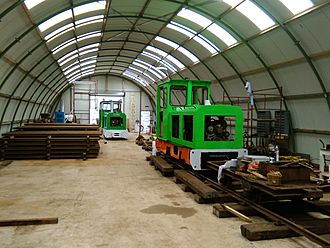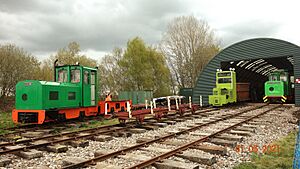Crowle Peatland Railway facts for kids
Quick facts for kids Crowle Peatland Railway |
|
|---|---|

Schomas 5220 of 1991 (front) and 5129 of 1990 (rear) in Crowle Peatland Railway's Romney Hut
|
|
| General information | |
| Status | Railway Museum |
| Town or city | Crowle, Lincolnshire |
| Country | England |
| Coordinates | 53°37′04.00″N 0°51′21.00″W / 53.6177778°N 0.8558333°W |
| Opened | 2016 |
The Crowle Peatland Railway is a special railway museum. It is located on the peat moors near Crowle in North Lincolnshire, England. This museum helps visitors learn about the history of peat railways. It shows how peat was once collected and moved from the moors.
Contents
The History of Peat and Railways
Early Peat Use and Industry
The Thorne and Hatfield Moors are areas of land with a long history. People used to dig up 'peat' there. Peat is like a very old, decayed plant material. Around the 1620s, a man named Cornelius Vermuyden tried to drain the Hatfield Chase area. This caused problems. Local people argued with new settlers who moved onto the drained land.
To fix these issues, a special group was formed. In 1630, they gave 'turbary rights' to local people. This meant they could cut peat for their own use. They were not allowed to sell it to others. In the 1800s, people tried to improve the moors for farming. But by the late 1800s, the focus changed. Companies started digging peat to sell it.
In 1896, several peat companies joined together. They formed the British Moss Litter Company. This new company controlled most of the peat work on the moors. They began building narrow railways called tramways. These tramways were 3 ft (914 mm) wide. They were used to carry the cut peat from the moors to the factories.
In the 1950s, horses were replaced by small trains called locomotives. These locomotives moved the wagons around the railway system. As some factories closed, the tramways were connected. The British Moss Litter Company was later bought by Fisons in 1963. Other companies took over after that.
Peat Extraction on Crowle Moor
Crowle Moor is like an extension of Thorne Moor. In 1630, people in Crowle also got rights to cut peat. This land was about 400 acres (160 ha). Over the years, several small peat factories were built in Crowle. They were all near Moor Middle Road. The British Moss Litter Company also took peat from Crowle Moors. But this stopped in 1956 after a big fire.
The longest-running peat site on Crowle Moor was at Moors Farm. Horses used to pull wagons of hand-cut peat to a factory there. Clifford Cowling bought the farm in 1940. In 1947, he started the Scientific Peat Company. Later, the company was renamed Poly-Peat Products in 1960. This company was known for using plastic packaging for peat. Other companies used the factory later on. Fernmoor UK Limited was the last peat company there. It started in 2002.
From Industry to Nature Reserve
The moors began to change from a busy industrial area to a nature reserve in 1971. Fisons agreed with the Lincolnshire Wildlife Trust to manage 144 acres (58 ha) of Crowle Moor. This area became a nature reserve. The Trust bought more land in 1987. In 1994, Fisons gave 2,340 acres (9.5 km2) of moorland to English Nature. This happened because environmental groups wanted to protect the moors.
The government bought the rights to dig peat from Scotts in 2002. They paid £17 million for Thorne and Hatfield Moors. After this, most peat digging stopped. However, Scotts continued to remove already cut peat until 2005. By the end of 2005, about 4,020 acres (16.25 km2) of Thorne and Crowle Moors became a National Nature Reserve. The Lincolnshire Wildlife Trust manages most of Crowle Moors.
The peat factory at Crowle, run by Fernmoor, was operating without permission. The local council tried to shut it down. Peat digging continued until 2007. This was after a long public investigation. Fernmoor closed down on 25 September 2007.
Starting the Railway Project
After peat digging stopped, Crowle and Thorne Moors became part of the Humberhead National Nature Reserve. The old railway tracks were removed. But some equipment was left behind. This included a Simplex locomotive and some peat harvesting machines. A group was formed to save the locomotive. They wanted to restore it and build a short railway track. This would help share the history of the peat railways.
Natural England did not approve the original plan. But they supported the group's goals. They gave the locomotive and machines to the group. These were moved off the moors in 2015. They were stored on a local farm for a while.
In 2014, the group found two original Schoma locomotives for sale. These had worked on the moors before. The group bought them in 2015. They also got three 'slave units' (flat wagons that could be powered). The old Poly-Peat site became the new home for the railway. The group changed its name to Crowle Peatland Railway.
They received £10,000 in funding from the local council and a partnership. This money helped restore the locomotives. The partnership also got a large grant of £1.84 million from the Heritage Lottery Fund. This helped many local projects, including the railway. The Schoma locomotives arrived at Crowle on 10 May 2016. They were stored in a special building called a Romney hut. The Simplex locomotive joined them later.
The railway then received another grant of £23,000. This money was for building a new Romney hut. This new building would be a workshop. Planning permission was given on 30 June 2017. The Schoma locomotives moved into the finished workshop on 5 September 2018. The Simplex locomotive went to North Lindsey College. Engineering students there helped restore it as part of their studies.
By May 2019, the Romney hut did not have electricity. The power company worked to connect it. This provided power for the workshop machines. In June 2019, the railway received £107,000 from North Lincolnshire Council. This money was for a visitor centre, education facilities, a shop, toilets, and a cafe. Crowle Moors is a Site of Special Scientific Interest (SSSI). The visitor centre helps people learn about the moors' history. The railway has built about 550 yards (500 m) of track. The locomotives can now run on this track.
Rolling Stock (Trains and Wagons)
Between 1947 and when peat digging stopped, 23 different locomotives worked on the moors. These were all small, 4-wheel vehicles. They came from various manufacturers. Nine locomotives were saved for preservation. Eight of them are in private collections. One Lister locomotive, built in 1964, was loaned to Doncaster Museum in 2007.
One locomotive was left behind at Bank Top around 1996. This is the one that inspired the railway project. It was a 40 hp (30 kW) Simplex locomotive. It was made by Motor Rail in 1967. Fisons bought it new. When it was new, it had a low cab (driver's area). But many locomotives had their cabs made taller. This allowed drivers to stand up and see over the wagons. This Simplex locomotive had a taller cab by 1992.
During its restoration, the main parts of its engine were found to be very worn. This was likely why it was left on the moors. Students at North Lindsey College started the restoration. Volunteers finished the work. It ran again on its own power by 19 June 2021. Its restoration was even nominated for an award in 2023.
In 1990, Fisons bought two new Schoma locomotives from Germany. These were larger than earlier trains. They weighed about 5 tonnes. They were powerful, with 86 hp (64 kW) engines. They were 4-wheel diesel hydraulic machines. Each came with a 'slave unit'. This looked like a flat wagon. It weighed about the same and had hydraulic motors. A third Schoma locomotive was bought the next year. One of these, number 5220, was named The Thomas Buck in 1993. It was named after a retired worker.
Two of the Schoma locomotives were rebuilt with stronger engines. The third one, number 5220, was not rebuilt due to costs. When railway operations stopped, one Schoma (5130) was placed at the Hatfield Works entrance. The other two were stored.
The two remaining Schoma locomotives and all three slave units came to Crowle on 10 May 2016. The third Schoma locomotive was given to the railway in June 2019.
In June 2020, the railway bought a Lisbon tram, number 711. It had been stored in Britain for years. The railway plans to keep its inside looking original. It will not run on its own power at the railway.
The Rail Trolley Trust loaned a Wickham trolley and a trailer to the railway in 2021. The trolley is a special powered vehicle. It was built in 1961 for the Lochaber Narrow Gauge Railway in Scotland. It was saved in 1978. It moved to a few different places before coming to Crowle. The trailer was also once a trolley.
In June 2024, the railway bought a Hunslet Wagonmaster, number LM336. This came from a peat railway system in Ireland that closed. It was brought to Crowle. It is being prepared to be used on the railway.


